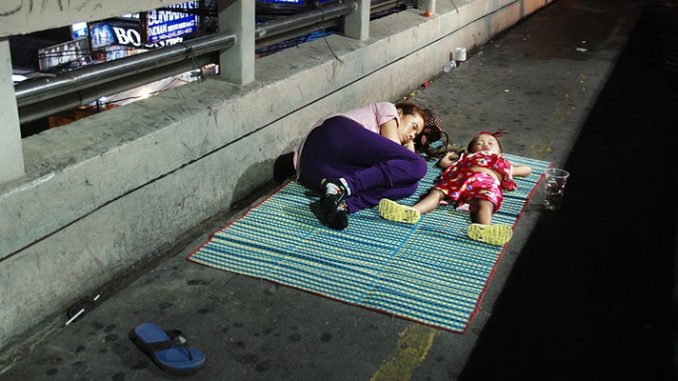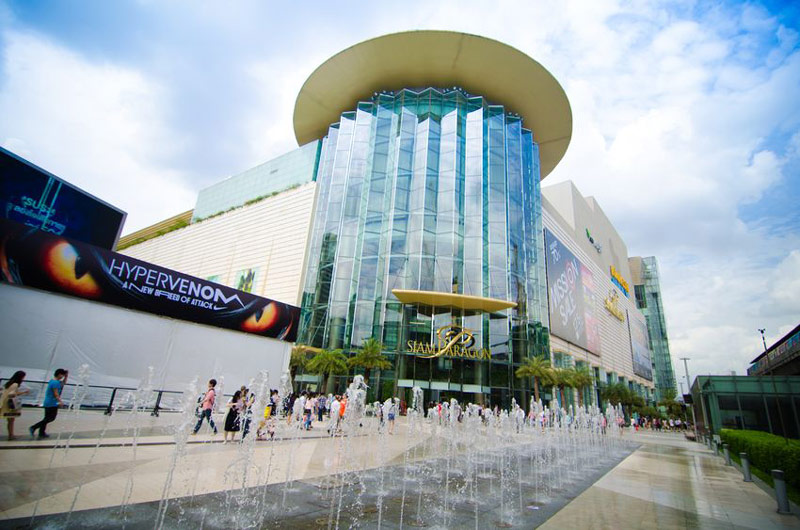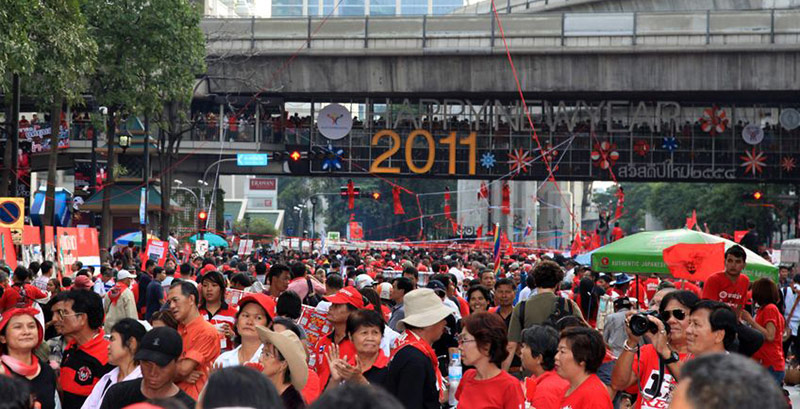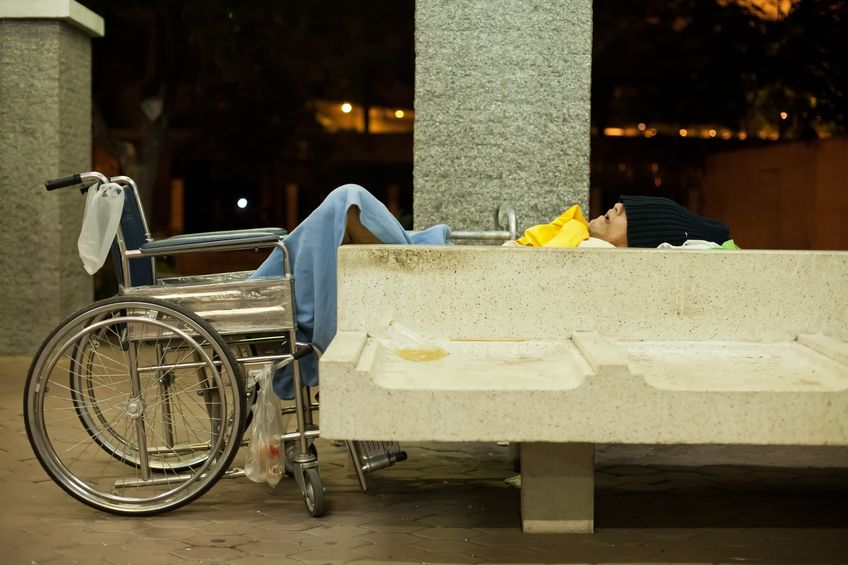
POVERTY, INCOMES AND INEQUALITY
Economic and political inequalities in Thailand are mutually reinforcing conditions that have resulted from the ways in which the gains of rapid economic growth have been captured by elites. Preserving these privileges produces a political structure that is exclusionary and dominated by an authoritarian elite. Through much of its period of rapid economic growth from the 1950s, authoritarian regimes dominated, promoting capitalism and incubating capitalist and middle classes, while restricting political rights. Growth reduced poverty but inequality remained high. Hence, while growth was beneficial for most, it was the capitalist class and its allies who captured the gains.
Poverty did not reduce inequality because income increases were concentrated with the well-off. At 0.45 to 0.53, the Gini index has remained high since the 1980s and is reproduced for other measures of wealth. Data from 2007 show that the top 10% of families controlled more than 51% of wealth while the bottom 50% controlled only 8.5%. For land, houses and other assets, just 10% of the population owns about 90% of privately-owned land. Other data demonstrate a redistribution of income from labour to capital, with productivity increases by labour having largely accrued to capital through increased profits. Until late 2011, stagnating real wages were a part of this pattern.

EXPLAINING INEQUALITY
This pattern of exploitation and inequality has existed for a long time. In fact, researchers have recounted similar data to that cited above over several decades. In the 1960s, Bell identified large surplus transfers from the poor Northeast region, ‘underdeveloping’ the region as producers were exploited by low wages and poor agricultural returns. 1 Three decades later, Teerana concluded that reduced poverty had not reduced the income gap and showed that Thailand’s inequality was high when compared with other Asian economies. 2
What are the reasons for the persistence of inequality? This is best answers are to be found in state policy and the structural power of capital.
State and policy
Studies of state policy indicate a long-standing rural-urban divide. State-promoted industrialization resulted in a larger working class, but with high capital intensity, the sector could not absorb the rural migrants who moved to urban areas for work. The result was a large informal sector where workers remained outside the state’s limited welfare system. This contributed to inequality as state transfers were directed to the small formal sector.
Likewise, the state’s investment in education has been concentrated in urban areas. When the economy grew rapidly, state expenditure on education remained low for a long period. In the 1960s, when farmers and workers constituted 85% of the population, only 15.5% of university students were from these groups. By the mid-1980s, this rate had declined to just 8.8%. Thus the lower classes were excluded from an important avenue out of low-paid and low-skilled work.
Taxation policies have also discriminated against the poor. High rates of manufacturing protection discriminated against agriculture, and for decades a regressive rice tax transferred wealth from the countryside to cities. By the 1990s, a range of regressive taxes meant that the rich gained from the tax system. In 2012, the state’s fiscal policies and expenditure remained pro-rich. The impact of these policies has been redistributive, from the poor to the rich.
These programmes have been supplemented by a low-wage/high-profit policy that has been maintained by government and business and has transferred wealth to capital.
Class and power
The political power required to maintain the low-wage/high profit strategy is a set of state and business strategies involving law, policy, ideology and coercion. For most of the period of rapid economic growth, subaltern politics was restricted, often heavily repressed. These class-based strategies sought to maintain authoritarian regimes by limiting electoral politics.
Clientelism or ‘money politics’ marginalizes the policy attention to inequality by garnering particularistic political support, and was the dominant politics, at least until 2001. When elections were held, they involved such an array of parties that coalition governments were always weak and short-lived and the parties involved never developed policies beyond local handouts. This politics excluded the majority and kept representative institutions weak, allowing the military and monarchy to dominate. The result was that inequality was not addressed by political elites and excluded groups have had to accept particularistic political goods rather than programmatic attention to issues of redistribution, at least until Thaksin Shinawatra was elected in 2001.
RESPONDING TO INEQUALITY
Inequality and the structures that maintain it has been challenged. Most recently, the prolonged red shirt protests of 2009 and 2010 was one such challenge. In rejecting the 2006 coup there emerged a linking of inequality with debates about democratization. This linking resulted from a series of political and economic crises that began with the 1991 military coup, the subsequent May 1992 civilian uprising, and the end of the long boom in 1997. The 1997 constitution resulted and it changed political rules.
The only governments elected under the 1997 constitution were Thaksin’s in 2001 and 2005. Formed in 1998, Thaksin’s Thai Rak Thai (TRT) Party became electorally popular due to policies promising change for the poor. A farmer debt moratorium, community-level soft loans and, most politically-defining, universal health care. For the first time, a political party promised – and delivered – programmatic and universal programs addressing poverty and welfare. The economic downturn that began in 1997 weakened the elite, and its fear of social conflict was sufficient for it to accept Thaksin’s political deal with the masses.

Not only did TRT become extraordinarily popular but voters discovered that a more responsive government was possible. These consequences unsettled the elite. Royalists feared popularly-elected politicians and considered Thaksin dangerous as he seemed to establish a popularity that competed with the monarchy. Following Thaksin’s landslide re-election in 2005, palace figures like Privy Council President Prem Tinsulanonda saw a diminution of the monarchy’s political centrality as a threat, and this perception unleashed a still unfinished political struggle to limit electoral politics.
Conservatives saw elections as posing threats to their view that politics should operate with the monarchy as the paramount institution. They saw electoral politics as undermining the monarchy’s foundational role for the social and political order. Thaksin also challenged the status quo by shaking up the bureaucracy, making it more responsive to elected politicians and the public. In reshuffling bureaucrats and restructuring ministries, Thaksin promoted his favourites, and for senior bureaucrats, for decades attuned to controlling the population, this was threatening. Likewise, Thaksin challenged the capitalist class by demanding that domestic business be more competitive. Opponents saw this as Shinawatra companies gaining a competitive edge and considered this rearrangement of economic power threatening.
Thaksin was not fully aware of the threat he posed for the elite’s political coalition of palace, military and business, and his failure to observe traditional hierarchies meant he was identified as dangerous. Thaksin’s attention to the lower classes meant an array of conservative, hierarchical and authoritarian forces came to oppose his government. The result was the 2006 coup. The coup did not end this contestation as red shirts and other Thaksin supporters opposed the palace and military. Demanding new elections in 2010, red shirts engaged in a prolonged protest, focusing their political rhetoric on status and inequality.
Protesters famously adopted an ancient word for bonded commoner – phrai – to designate their position vis-à-vis the ammat or ‘ruling aristocrats’. They emphasized double standards in law, the ammat’s monopolization of political power, and a deeply-felt resentment of inequality. Despite claims that the red shirts were radical, their demands were reformist: ‘We want a free capitalist state in which the gap between the rich and the poor is reduced. We want to create more opportunities for the poor’. 3 This appeal to class and status angered the elite, especially as the protests developed considerable subaltern solidarity.
This solidarity was reflected in the coincidence of political mobilization, voting patterns and economic data. Voting patterns aligned with low incomes and poverty incidence, with the poorest areas in the North and Northeast, several provinces in the Central region and working class areas around Bangkok consistently voting for pro-Thaksin parties. The average per capita gross provincial product in provinces voting for the elite-supported Democrat Party in 2007 was almost 2.4 times higher than in the provinces supporting the pro-Thaksin party.

THE POLITICS OF INEQUALITY
Relatively low incomes, skewed ownership and the siphoning of income to the already rich indicate a long-standing pattern of exploitation. While there have been revolts against this exploitation, these have not altered this pattern. The elite usually responds to such ‘rebellion’ with repression. When the challenges have resulted in electoral politics – as protesters demanded in 1973, 1992, 2009 and 2010 – one outcome has been clientelist politics that allow civilian politicians to be denigrated as evil and corrupt. This denigration permits military and royal interventions re-establishing repression, authoritarianism and elite domination. When the elite rules, its stresses its right to rule, drawing on exclusionary conceptions of order, authority and morality. At the heart of this system is a claim that the monarchy is indispensable and that the elite rules with the king’s moral authority.
Those who contest this ideology repeatedly demand political representation and policies that challenge embedded exploitation. Most notably there has been a dogged support for electoral politics. Since the 2006 coup, when elections have been permitted, voters have turned out in large numbers and have repeatedly returned pro-Thaksin governments. This is not simply pro-Thaksinism but amounts to a support for electoral politics and parties perceived as representing subaltern interests. Rural and working class electorates appear to reject clientelist politics and want society might be better organised, less hierarchical less exploitative.
For many red shirts, democracy came to mean electoral politics instead of coups. Related, inequality was identified as ‘double standards’ in a range of arenas from the courts to political power. The official red shirts demanded a state where ‘political power really does belong to the Thai people’. They wanted a ‘fair and just state’, where ‘the people are free of the aristocratic oligarchy (ammat) and have pride, freedom and equality’. 4
These demands for freedom, justice and equality have seen a bitter struggle for control of the political system. These demands have been met by the elite’s use of the judiciary, the military’s guns, and repeated royalist demonstrations. The 22 May 2014 military coup resulted and has witnessed a determined effort to neuter politicians outside the royalist elite and to roll back electoral politics.
CONCLUSION
If he time-travelled to today’s Thailand, Tocqueville would not find the ‘general equality of conditions’ that characterized early American democracy and structured that society. Rather, he would see the prodigious and pernicious influence of a social, political and economic system that is structured to maintain inequality.
Kevin Hewison
Asia Research Centre, School of Management & Governance, Murdoch University, Perth, Western Australia
Kevin Hewison is Sir Walter Murdoch Professor of Politics and International Studies and Director of the Asia Research Centre at Murdoch University. Previously he was Weldon E. Thornton Distinguished Professor at the University of North Carolina at Chapel Hill.
Issue 17, Kyoto Review of Southeast Asia, March 2015
REFERENCES
Bell, P. “Thailand’s Northeast: Regional Underdevelopment, ‘Insurgency’, and Official Response”, Pacific Affairs 42, no. 1 (1969): 47-54.
Teerana Bhongmakapat. “Income Distribution in a Rapidly Growing Economy: A Case of Thailand”. Paper presented to the 15th Conference of the ASEAN Economic Associations, Singapore, November 15-17, 1991.
UDD/No Pho Cho. Kham tham lae kham dop ruang no pho cho. Daeng thang phaendin. [Questions and Answers on UDD: the Red Land] Bangkok: UDD/No Pho Cho, April 28, 2010.
